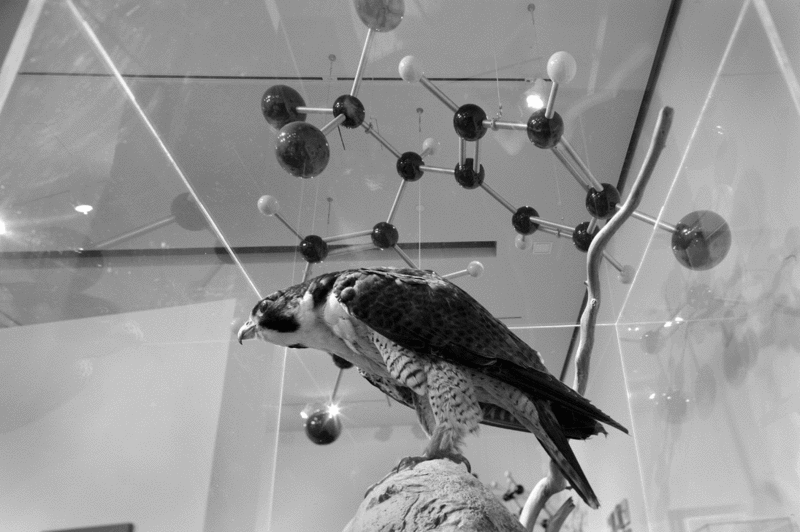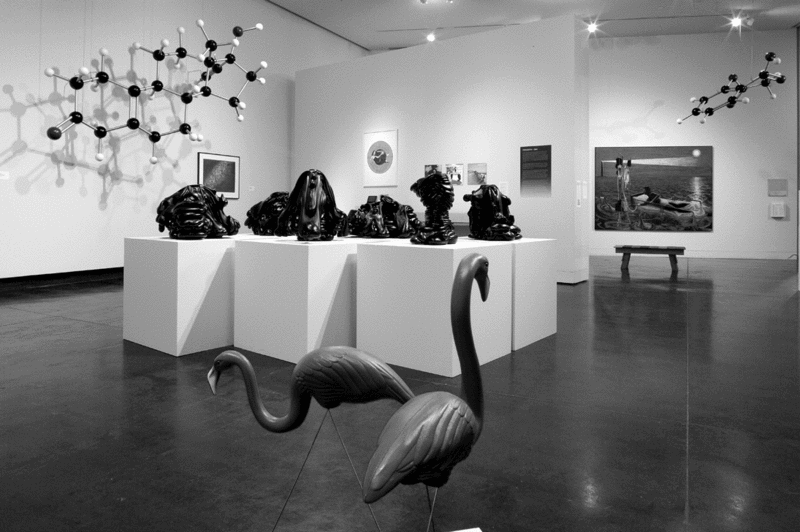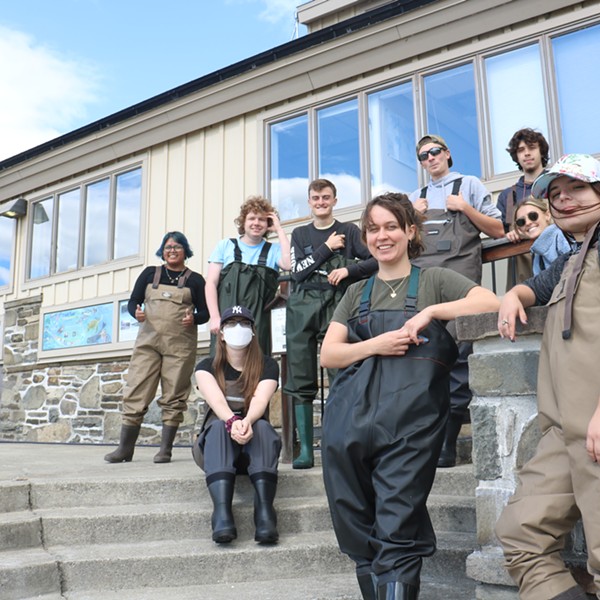Which do you suppose is more daunting to the average American—art or science? The fact that both are a challenge has mobilized many a museum to combine the two in an almost counterintuitive effort to make one or the other seem more user-friendly, or more meaningful—or both—and thus reach a wider audience.
The latest regional example of this trend offers strong doses of both art and science, and leavens them with a healthy shot of popular culture, making for a show that is educational and entertaining. “Molecules That Matter,” at Skidmore College’s Tang Teaching Museum, was curated by Skidmore chemistry professor Raymond Giguere and Tang director John Weber, in partnership with the Philadelphia-based Chemical Heritage Foundation, the source of many of the objects on display. CHF is a nonprofit consortium of educational and corporate entities dedicated to historical preservation and contemporary education about chemical and molecular science.
The premise of the show is that certain carbon-based (that is, organic) molecules have greatly affected our everyday lives, whether we know it or not. With help from a team of leading scientists, the curators chose 10 molecules to build the show around—one discovered or synthesized in each decade of the 20th century—and then structured a display for each that incorporates visual art, historical artifacts, and extremely large three-dimensional models of the molecules.
Some of these chemicals—aspirin, for instance—are totally familiar. Others, such as buckminsterfullerene, we probably wouldn’t recognize. The rest run the gamut in between: They are isooctane, penicillin, polyethylene, nylon, DNA, progestin, DDT, and Prozac. Doubtless, some of the candidates that were ruled out were also strong, but all of these are amply and clearly shown to be worthy of inclusion, based on the far-reaching impacts they have had on our lives and the life of the planet.
The exhibition strikes a nice balance between solid intellectual content and ease of taking it all in. Whether you are adept at art or science (or neither), you will not be put off by overly exhaustive detail (often a failing of ambitious art exhibitions), too much directive signage (as in many science museums), or impossible-to-navigate clutter. Neither will you feel insulted by dumbed-down information. My barely passing work in high school chemistry left me, some 35 years later, with enough of a grasp of the subject to be comfortable with most of the science in the show (and those stick-and-ball models are a fun flashback); equally, the art is presented intelligently but without pretense.
That’s the meat of the show; but it’s all tied together by a tasty starch of pop-culture icons and oddities—from the two plastic pink flamingos strutting in the polyethylene section to a fabulous video loop of famous movie car chases illustrating the value of isooctane—and that’s what makes the show both fun and fundamental. We all know that Prozac practically defined a generation—but it’s powerful to see that truth made plain in the form of a gridlike array of 35 different mass-market books with the antidepressant’s name in their titles. And, while everybody knows that plastic is everywhere, we may not have realized that the long, pure-carbon molecules of buckminsterfullerene—so named because their structure resembles the visionary-architect-designer Buckminster Fuller’s geodesic dome—give us stronger, more resilient golf clubs, baseball bats, tennis rackets, and bicycle frames.
The artwork, about equally divided among painting, photography, and sculpture, is mostly high quality and, in a few cases, world-class. My favorites include: Susie Brandt’s After Albers, a large wall-hanging made by piecing together numerous summer-camp potholders woven from stockings (representing nylon); a sinuous group of taffylike black plastic sculptures made by a machine that Roxy Paine adapted to her use (polyethylene); three pink marble renderings of genetically modified mice that portray Gluttony, Sloth, and Anger by Bryan Crockett (DNA); and a classic Ed Ruscha print of a California gas station titled Mocha Standard (isooctane).
Also of note are three oil paintings on panel made specially for the exhibition by California artist Melissa Gwyn (a much earlier watercolor of hers is also included) that pertain to Prozac, DDT, and buckminsterfullerene; Tony Cragg’s ingenious 1985 wall piece New Figuration, which turns common trash into a soaring, comic book–inspired treasure (polyethylene); Fred Tomaselli’s staid, square, pinstripe painting imbedded with little white pills (aspirin); and a colorific Michael Oatman collage titled Code of Arms (DNA), which was part of his Tang retrospective a couple of years ago and never left the museum.
Some of the other art borders on kitsch—or, to be more generous, camp—such as Alexis Rockman’s oversized bodice-ripper-meets-2001 painting Romantic Attachments (DNA), Thomas Asmuth’s soft sculpture Fluoxetine (Prozac), and Chrissy Conant’s creepy comment on modern fertility that features her own viable egg in a little fridge.
Many of the scientific artifacts in the show are as compelling as the best art. A glass flask designed for culturing penicillin, with its mouth stretched wide to receive a slice of bread, is elegantly innocent; a stuffed peregrine falcon stands in mute testimony to the near-destruction of its species by DDT’s ripple effect; and the super-geeks among us will drool over the original (circa 1985) AP2 Supersonic Laser Vaporization Cluster Beam Apparatus that helped earn Richard Smalley and colleagues a Nobel Prize for the discovery of buckminsterfullerene, a key component in nanotechnology.
All this, along with a trove of printed matter—early car ads with horses offering commentary on engine knock; manufacturers’ promotional materials for Prozac; an alphabetical list of things made out of nylon (from applicators to pincushions to yarn); and a 1969 magazine cover that illustrates a story on the birth control pill (progestin) with an image of a man’s hand popping one into a wide-eyed woman’s mouth—makes “Molecules That Matter” a must-see. While there are elements of the show that are beyond the everyday person’s ken, the spirit of the show is not. If it can help us feel more equal to chemistry, and thus more able to judge good science from bad, we can then keep a sharper eye on those who wield its power.
“Molecules That Matter” continues through April 13, 2008 at the Frances Young Tang Teaching Museum and Art Gallery at Skidmore College in Saratoga Springs. (518) 580-8080; www.skidmore.edu/tang.


















